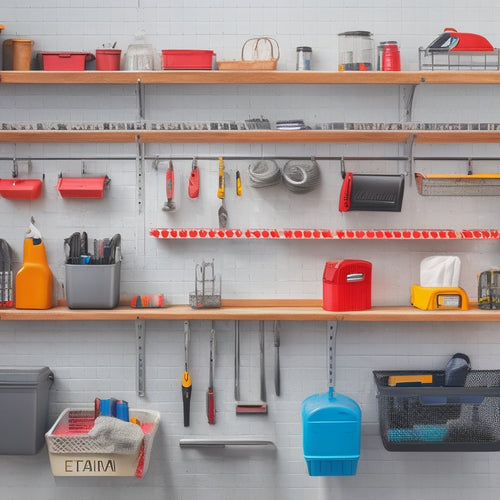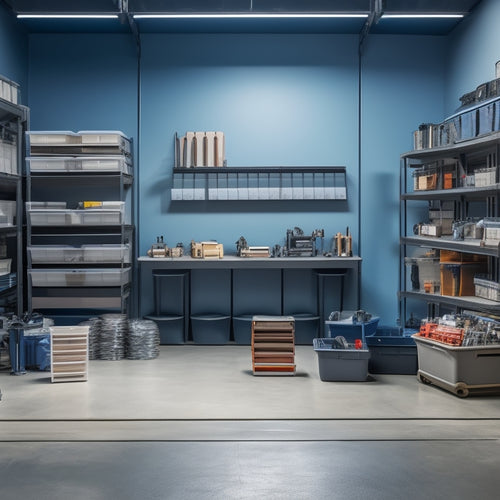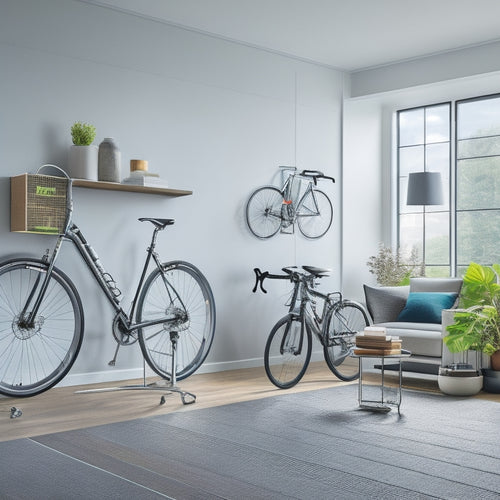
What Size Rolling Storage Bin Do I Need
Share
To determine the ideal size of your rolling storage bin, you'll need to measure your storage space accurately, considering width, depth, and height, as well as any obstacles like pipes, shelves, or corners. Factor in extra space for easy access to stored items and ascertain you have a snug fit to optimize storage efficiency. Identify the items you'll be storing, their dimensions, and weight to calculate the required volume and capacity. By doing so, you'll get a better sense of the bin size you need, and with a clear understanding of your storage needs, you'll be well on your way to finding the perfect fit.
Key Takeaways
- Measure the designated storage area, factoring in obstacles and extra space for easy access to stored items, to determine the ideal bin size.
- Evaluate the dimensions and weight limits of items to be stored, ensuring the bin can accommodate them safely and efficiently.
- Consider the shape of items and available space when selecting a bin size, opting for a snug fit to optimize storage efficiency.
- Assess the frequency of item access, storage goals, and environmental conditions to determine the right bin size and material for your needs.
- Choose a bin height that allows for comfortable and safe access, considering the size and weight of items and the type of storage space.
Measuring Your Storage Space Needs
When deciding on a rolling storage bin, measuring your storage space needs is crucial to confirm you choose the right size. You don't want to end up with a bin that's too small to hold your items or too large to fit in the allocated space. To ascertain ideal storage organization and space optimization, take precise measurements of the area where the bin will be placed.
Consider the width, depth, and height of the space, as well as any obstacles like pipes, corners, or shelves. Measure the doorways, hallways, and stairways the bin will need to pass through to reach its final destination. Record these measurements to refer to later when selecting a bin.
Additionally, think about the items you plan to store in the bin. Are they bulky or compact? Do they've irregular shapes or sizes? Factor in some extra space for easy access and retrieval of your items.
Understanding Bin Dimensions and Capacity
You'll need to evaluate bin size and capacity to guarantee you're getting the right fit for your storage needs.
Measure your storage space to determine the maximum size of the bin that will fit comfortably.
Then, think about the volume and weight limits of the items you plan to store, as these will impact the capacity you require.
Bin Size and Capacity
Determining the ideal size of your rolling storage bin starts with understanding its dimensions and capacity. You need to take into account the bin's length, width, and height to guarantee it fits your storage space and holds the items you want to store. Bin size is typically measured in inches, and capacities range from a few gallons to several dozen gallons.
When choosing a bin, think about the shape of the items you'll be storing. For example, if you need to store long, thin items like brooms or mops, a tall, narrow bin might be the best fit. On the other hand, if you're storing smaller, bulkier items like cleaning supplies, a shorter, wider bin might be more suitable.
Bin weight is also an important consideration, as heavier bins may be more difficult to move around. You should also take into account the bin's material and construction. Sturdy, durable bins with reinforced handles and wheels can support heavier loads and withstand regular use.
Measure Your Storage Space
To guarantee a seamless fit, measure your storage space carefully before selecting a rolling storage bin. Take precise storage measurements to ascertain the bin fits snugly in the designated area.
Consider the space's width, length, and height to determine the maximum size of the bin. Don't forget to account for any obstacles, such as pipes, corners, or shelves, that may impact the bin's placement.
When taking measurements, use a tape measure to record the dimensions of the storage area. Record the measurements in inches or feet, depending on the unit of measurement used by the bin's manufacturer.
For space planning, consider the bin's dimensions in relation to the storage area's layout. Will the bin fit easily through doorways or around corners? Are there any tight spaces that may require a smaller bin?
Volume and Weight Limits
Beyond the physical dimensions of your storage space, it's essential to contemplate the volume and weight limits of your rolling storage bin.
You need to guarantee that your bin can hold the amount of items you plan to store and that the weight is evenly distributed to prevent accidents.
When calculating the volume of your storage bin, consider the following factors:
-
Volume calculations: Calculate the total volume of the items you plan to store by multiplying the length, width, and height of each item.
-
Weight distribution: Confirm that the weight of the items is evenly distributed within the bin to prevent it from tipping over.
-
Maximum weight capacity: Check the manufacturer's recommended maximum weight capacity for the bin to verify it can handle the total weight of the items.
Common Rolling Storage Bin Sizes
Taking into account your storage needs, you'll find that rolling storage bins come in a variety of sizes to fit different spaces and applications.
Standard sizes are available to accommodate most storage requirements, ranging from small bins (10-20 gallons) for tight spaces to large bins (50-100 gallons) for bulk storage. These standard sizes guarantee that you can find a bin that fits your needs without having to sacrifice too much floor space.
In addition to standard sizes, you can also opt for custom options to fit unique spaces or applications. For instance, you might need a bin with specific dimensions to fit under a workbench or in a corner. Custom bins can be designed to meet these needs, providing a customized solution for your storage requirements.
When selecting a rolling storage bin, it's crucial to take into account the size of the items you need to store, as well as the available space in your facility.
Factors Affecting Bin Size Choice
When deciding on a rolling storage bin size, you're not just thinking about the bin itself, but also the items you need to store and the space where the bin will sit.
This means considering the dimensions of the items you want to store, as well as the available floor or shelf space where the bin will be placed.
Several factors can influence your bin size choice, including:
-
Bin shape: A tall, narrow bin might fit perfectly in a corner, while a shorter, wider bin could be better suited for under a shelf.
-
Aesthetic appeal: If the bin will be visible in your home or office, you may want to choose a size that complements the surrounding decor.
-
Mobility: If you plan to move the bin frequently, a smaller size might be more convenient, while a larger bin might be better suited for stationary storage.
Assessing Your Storage Container Needs
You'll want to start by identifying your storage goals - what do you want to store, and how often will you need to access those items?
Next, take stock of the space where you'll be placing the bin, measuring the available width, depth, and height to guarantee a good fit.
Identify Storage Goals
Before deciding on a rolling storage bin, take stock of your storage needs by evaluating what you want to store and how often you'll need to access those items. This will help you identify your storage priorities and determine the ideal size of your rolling storage bin.
To get started, consider the following:
-
Categorize items: Group similar items together, such as cleaning supplies, office materials, or seasonal decorations. This will help you visualize how much space each category will require.
-
Assess frequency of use: Determine how often you'll need to access each item or category. This will help you decide whether you need easy access or can store items that you rarely use in a larger bin.
-
Evaluate item size and shape: Consider the size and shape of each item, including any bulky or irregularly shaped items that may require more space.
Determine Space Availability
Now that you've identified your storage goals, it's time to assess the space where you plan to store your rolling storage bin.
Take a closer look at the area and consider the space constraints you're working with. Measure the width, length, and height of the space to determine the maximum size of the storage bin that will fit comfortably.
Consider the layout of the room and any obstacles that may affect the placement of the bin. Think about the doorways, hallways, and corners that the bin will need to maneuver through.
Will the bin need to fit under a shelf or inside a closet? Make note of any narrow passages or tight spaces that may require a smaller bin.
Count Items to Store
With your storage space assessed, it's time to focus on the items you need to store. Counting and categorizing the items will help you determine the right size of rolling storage bin for your needs.
Make a list of the items you plan to store, including their dimensions and quantities. Consider the following:
-
Item types: Are you storing small items like office supplies, or larger items like tools or equipment?
-
Storage frequency: How often will you need to access the items in the storage bin?
-
Item sizes and shapes: Are there any unusual or oversized items that require special consideration?
Once you have an all-encompassing list, you can start thinking about the storage bin's capacity and organizational features.
Will you need dividers, compartments, or labels to keep your items organized and easy to find? By considering these factors, you'll be able to choose a rolling storage bin that meets your specific needs and keeps your items safe and secure.
Considering Your Room's Layout
Frequently, the most overlooked aspect of choosing the right rolling storage bin is the room's layout. You must consider the room dimensions and how they'll impact the bin's size and placement. Measure the width, length, and any obstacles like doorways, pillars, or heaters to ascertain the bin fits comfortably.
Next, examine your furniture arrangement. Identify the areas where you need additional storage and the paths you frequently walk through. This will help you determine the best size and placement of the rolling storage bin. Consider the distance between shelves, desks, or other furniture to make sure the bin can easily slide in and out.
When selecting a bin, think about the room's traffic flow. You don't want the bin to obstruct pathways or create tripping hazards.
Choosing the Right Bin Material
You've considered the room's layout, measured the space, and identified the ideal placement for your rolling storage bin.
Now, it's time to think about the material that will best suit your needs. The right material can greatly impact bin durability and overall performance.
When choosing a material, consider the following factors:
-
Plastic bins: Lightweight, easy to clean, and resistant to corrosion. Ideal for general storage and dry environments.
-
Metal bins: Sturdy, durable, and suitable for heavy-duty storage. May be noisy and prone to rust in humid environments.
-
Fabric bins: Soft, breathable, and flexible. Perfect for storing soft items like clothes, toys, or linens.
Consider the items you'll be storing, the environment they'll be in, and the level of durability you need.
Thinking About Mobility and Handling
Several key considerations come into play when thinking about mobility and handling for your rolling storage bin. You need to think about how easily you can move the bin around, and how convenient it is to handle. This is essential, especially if you plan to use the bin in different areas or need to transport it frequently.
| Mobility Options | Handling Ease | Ideal Use Cases |
|---|---|---|
| 2-4 Casters | Easy to push/pull | General storage, frequent relocation |
| 4-6 Casters | Very easy to maneuver | Heavy-duty storage, tight spaces |
| Locking Casters | Secure, controlled movement | High-traffic areas, sensitive materials |
| Ergonomic Handles | Comfortable grip, reduced strain | Frequent handling, heavy loads |
When selecting a rolling storage bin, consider the mobility options and handling ease that best fit your needs. If you need to move the bin frequently or traverse tight spaces, look for bins with multiple casters or locking casters. If you'll be handling heavy loads or need extra comfort, consider bins with ergonomic handles. By prioritizing mobility and handling, you can guarantee a safe and efficient storage solution.
Selecting the Ideal Bin Height
Selecting the Ideal Bin Height
Three key factors will determine the ideal bin height for your rolling storage needs: the type of items you'll be storing, the space where the bin will be used, and your personal comfort level.
-
Consider the size and weight of the items you'll be storing: will you be storing large, heavy items or smaller, lighter ones?
-
Think about the space where the bin will be used: will it be in a tight, compact area or a more open space?
-
Reflect on your personal comfort level: do you prefer a bin that's easy to reach into or one that's lower to the ground?
When selecting a bin height, it's important to prioritize ergonomic design to guarantee safe and comfortable use.
A bin that's too tall can lead to straining or overreaching, while one that's too short may require excessive bending.
Frequently Asked Questions
Can I Use a Rolling Storage Bin Under My Bed?
You can definitely use a rolling storage bin under your bed to optimize bed space and improve storage organization, as long as you guarantee the bin's size and weight are safe for the bed's structure and your personal mobility.
Are Rolling Storage Bins Suitable for Outdoor Use?
When you're planning a backyard campout, remember how a waterproof tent saves the day? Similarly, you'll want a rolling storage bin that's weather-resistant and made with durable materials to withstand outdoor elements, ensuring your belongings stay safe and dry.
Can I Stack Rolling Storage Bins on Top of Each Other?
When stacking rolling storage bins, you'll enjoy benefits like maximized space and ease of access, but don't forget to prioritize safety concerns, like ensuring stable bases and secure latches to prevent toppling and damage.
Do Rolling Storage Bins Come With Locks or Latches?
You've got a million things to store, but first, let's talk security! Most rolling storage bins don't come with locks, but some offer various latch types, like snap-lock or cam-lock mechanisms, to keep your belongings safe and secure.
Are Rolling Storage Bins Easy to Clean and Maintain?
You'll be relieved to know that rolling storage bins are a breeze to clean and maintain! Follow simple cleaning tips like wiping with a damp cloth and maintenance hacks like lubricating wheels to keep them in top shape.
Conclusion
You've finally measured your space, considered your needs, and weighed your options. Now, it's time to choose the perfect rolling storage bin. Remember, "measure twice, cut once" - don't rush into a decision. Take a step back, review your notes, and trust your instincts. With the right bin, you'll be rolling your way to a more organized, clutter-free life in no time.
Related Posts
-

3 Simple Steps to a Garage Tool Wall You'll Love
To create a garage tool wall you'll love, start by planning the space, taking inventory of your tools, and measuring ...
-

How to Maximize Storage Space With Parts Storage Bins
To maximize storage space with parts storage bins, start by evaluating your available storage space and examining you...
-

Must-Try Bike Storage Ideas in Small Spaces
You're tired of sacrificing precious living space to store your bike, especially in small homes where every square fo...


